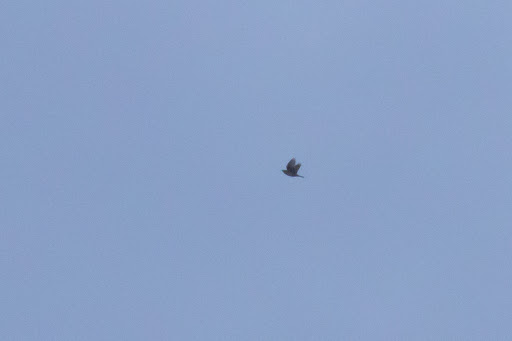Two recent local patch visits have produced a species that I spent much of last August listening and looking for, but without success: Tree Pipit. This species is a scarce migrant in Oxfordshire, but one that has history in this area. I spoke to Steve Heath early last year. Steve grew up in Cowley and used to watch the Southfield Golf Course area many decades ago. Steve told me that Tree Pipits used to be regular up on the golf course and even now I could see why. The open grassy spaces on top of the hill, the many mature pine trees combined with the sandy bunkers on the golf course, look as if they could tempt a passing migrant Tree Pipit down to investigate.
There was a significant movement of Tree Pipits across England in late August 2019, but despite many hours of observation by myself and Dave Lowe we did not record a Tree Pipit in the Lye Valley area. Last week I was in south Devon and saw, heard and photographed a number of Tree Pipits as they migrated down the coast. Their calls were fresh in my memory as I headed out on Tuesday morning.


First encounter: no confirmatory second call
As I descended from the golf course towards the trees of the Lye Valley on 25th August, I was stopped in my tracks by a buzzing “tzeep” flight call of a bird passing high overhead. I immediately called out “Tree Pipit!” I scanned the skies, cupped my ears and listened out another flight call. It never came.
I have long since stopped identifying birds on the basis of “what else could it have been?” If I find myself going down that particular avenue, it simply means that I have not gathered enough evidence to confirm the identification of the bird in question. There must be evidence from my own observation to substantiate the identification. Identification based on ruling everything else out that is not present, is by definition, much less secure.
I reflected that had I been on the Devon coast I would have simply added Tree Pipit to my eBird list and carried on. But in an Oxfordshire context, Tree Pipit was a new species for the Lye Valley area and a species that I had neither seen nor heard in the county. I needed more evidence. I needed the confirmatory second flight call. The one you hear when you are fully alert and listening. Not the first flight call, that can catch an observer unawares, where the mind can play tricks or the wind can distort the call of a more common species. For me, I needed to hear more than one call to reach a satisfactory evidence threshold to add a new species to my patch or county list. I gritted my teeth and headed into the woods.
Second encounter: the confirmatory call!
About eight minutes later, as I passed between the Churchill Hospital and the 18th green of the golf course (this is a strange local patch), I was stopped in my tracks by an explosive buzzing flight call from a bird high overhead. Again I stopped and scanned the skies and listened and this time the flight call was repeated as the bird moved south, sounding just like this recording:
[Albert Lastukhin, XC495491. Accessible at www.xeno-canto.org/495491]
It was a Tree Pipit! And I had heard the second confirmatory call. The one that for me, reduces the risk of an overactive imagination or wind distortion and nails the ID. Tree Pipit was on my patch and county lists. I went home a happy man.
Third encounter: “chip” calls
This morning I was back on the golf course at first light. I was unnaturally optimistic about finding a Redstart for some reason, but as usual drew a blank. As I searched the southern end of the golf course I once again heard the distinctive sound of a Tree Pipit’s standard flight call. This time it was relatively low and I managed to photograph the bird as it circled around overhead.

I watched and listened to it fly over the hilly southern edge of the course before losing sight of the bird. Then I became aware of some high pitched “chip” calls coming from a pipit-like bird flying back north over the golf course. These calls were unfamiliar to me. About 15 minutes later the bird making the “chip” calls flew back overhead, before inserting a classic Tree Pipit flight call between the chips notes. The “chip” calls were Tree Pipit alarm calls, just like this recording:
[B Whyte, XC566189. Accessible at www.xeno-canto.org/566189.]
The Tree Pipit continued flying east and I watched it leave East Oxford and fly until it was lost from view. An instructive morning and a small ambition fulfilled. It is good to know that this hilltop golf course in Oxford city can still attract migrating Tree Pipits in autumn.
